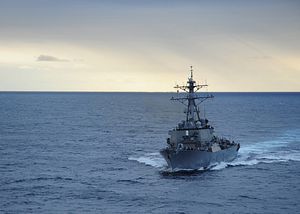In 2017, the United States challenged excessive maritime claims from multiple Asia-Pacific states. All together, the U.S. military’s ships and aircraft carried out freedom of navigation operations (FONOPs) to challenge illegal and excessive claims by Cambodia, China, India, Indonesia, Malaysia, Maldives, the Philippines, Sri Lanka, Taiwan, and Vietnam. Non-Asian states also featured prominently as the target of these FONOPs.
The U.S. Department of Defense released its annual freedom of navigation report for the 2017 fiscal year (PDF) outlining these operations. The document is the first to be released under the Trump administration and covers a particularly busy year for the U.S. Navy in the Asia-Pacific region, including in the East and South China Seas.
This year’s document, for the first time, provides a geographic breakdown of where specific excessive claims were challenged with freedom of navigation operations (FONOPs), both by surface ships and military aircraft. In Asia, U.S. FONOPs focused on the Spratly and Paracel groups in the South China Sea, the East China Sea, the Indian Ocean, the Sulu Sea, the Java Sea, and the Strait of Malacca.
The 2017 freedom of navigation report helps dispel the idea that U.S. FONOPs in Asia are targeted against Chinese claims specifically. Given China’s particularly capacious claims in the South China Sea and its construction of militarized artificial islands, U.S. operations in the vicinity of China-held features tend to receive more publicity, but the U.S. Navy has challenged excessive claims from all claimants in the area, including U.S. partners and allies.
In the South China Sea, the 2017 report points out the specific excessive Chinese claims that the U.S. Navy challenged over the course of at least four publicized FONOPs. (Other operations may have taken place, without publicity or reports in the press.)
According to the report, operations targeted China’s “excessive straight baselines” claims in the Paracel Islands, claimed “jurisdiction over airspace above the exclusive economic zone,” “domestic law criminalizing survey activity by foreign entities in the (exclusive economic zone),” “prior permission required for innocent passage of foreign military ships through the TTS (territorial sea),” and “actions/statements that indicate a claim to a TTS around features not so entitled.” (The latter is a reference to the much-anticipated FONOP around Mischief Reef, one of the sites for a Chinese artificial island in the Spratlys.)
In the East China Sea, U.S. military aircraft challenged China’s “restriction on foreign aircraft flying through an Air Defense Identification Zone (ADIZ) without the intent to enter national airspace.” China unilaterally declared an ADIZ in the area in 2013.
U.S. FONOPs are concerned solely with excessive maritime and airspace claims and not with the sovereignty of disputed features. The U.S. continues to maintain that it does not take any position on which country should exercise sovereignty over any given disputed feature, be it in the East China Sea, the South China Sea, or elsewhere. These operations are merely an attempt to assert rights permitted to warships of any country under the United Nations Convention on the Law of the Sea, which the United States treats as of customary international law even as it hasn’t ratified the Convention.
































